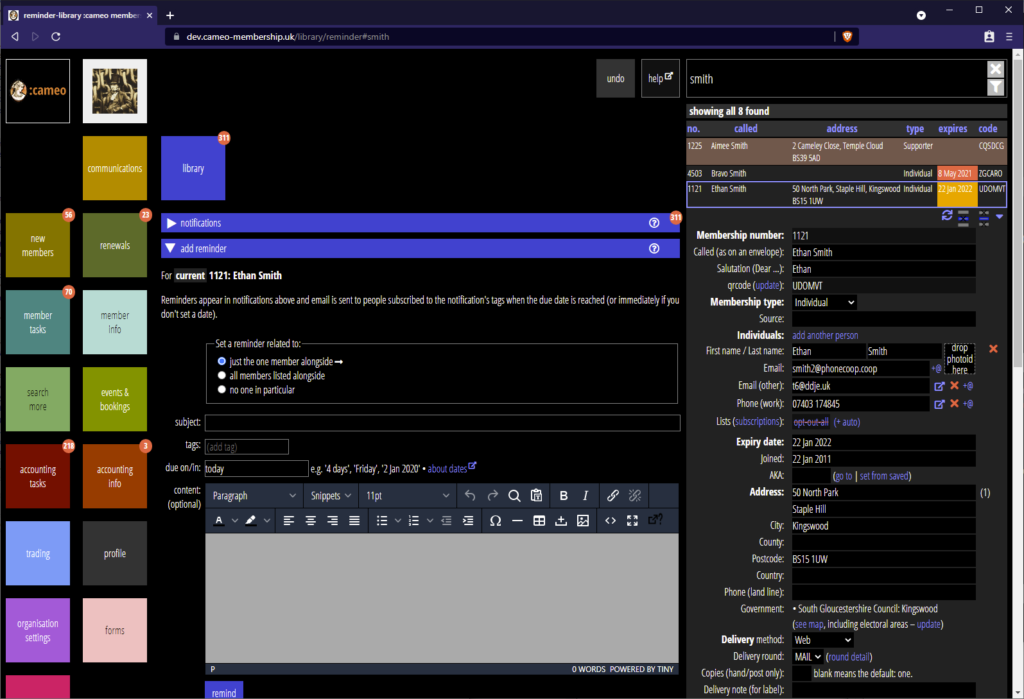You can now run Cameo in dark mode. By default it follows the device setting. However, you can always use dark or light if you prefer.

Contents
Background
Dark mode means working with light colours on a dark background instead of the more conventional dark colours on a light background. It is something of a current fashion. Most devices let you choose in the system preferences/settings. On many devices you can set it to switch according to time of day. Supported apps, and increasingly web pages, then follow the same style. If you do use dark mode, it is jarring to encounter an app or page that doesn’t. Though I think it is fair to say many more Windows apps than Mac or iOS do not yet support dark mode.
As well as being all the rage, people assert that it also:
- saves battery on mobile devices
- is easier on the eyes, especially viewing in low light.
Turning it on
Set your preference in profile → profile and log out. Scroll down to the dark mode preference sub-section (Fig 2).
If you don’t make a preference, dark mode will follow the device setting.
The page has to be re-loaded when you change your dark mode preference.

Follow the browser/device setting
You can choose to operate Cameo with dark details on a light background (light mode), vice-versa (dark mode) or based on the device setting for colour scheme.
When you follow the browser/device setting (which is the default), browsers decide differently when to use dark mode:
● Chrome (and Chromium)
Chrome follows the operating system setting, whatever theme you have installed, on all operating systems.
● Firefox
Firefox varies considerably on different operating systems:
- On Windows and Mac, Firefox follows the browser theme you have installed. You can choose System Theme in which case light/dark does follow the operating system colour scheme. Themes are managed from the settings menu → Add-ons and Themes → Themes.
- On Linux (Ubuntu 20), Firefox always follows the operating system setting (in Settings → Appearance) irrespective of theme.
- On iPad/iPhone, Firefox has an option in Settings → Theme → Use System Light/Dark Mode, which is on by default. If you turn it off you have more theme choices which together decide dark or light.
● Safari
On Mac and iOS etc, Safari always follows the operating system setting.
● Microsoft Edge (Windows)
Let’s you choose System Default, Light or Dark (or other custom themes, which all appear to behave as light) in Settings → Appearance. Light is the default, so you would have to change the browser setting for follow the browser/device setting to have any effect.
● Brave
Brave lets you choose from Same As Windows (or MacOS), Light or Dark, in Settings → Appearance, rather like Edge.
● Opera
Similarly, choose Light, Dark or System at the top of the settings menu.
● Pale Moon
At time of writing, Pale Moon does not recognise the operating system’s dark mode setting and has no other settings of its own to control light/dark mode. This is despite version 29, based on a rather old Firefox v68, having the necessary technology, which was introduced in v67. So you would have to choose light or dark explicitly in Cameo; follow the browser/device setting would always behave as light. This may well change in future versions.
Other things to note
- To avoid dazzle, some of the menu and link colours are also dimmed when dark mode is on.
- Likewise the new and old members background colours are darkened.
- Custom contact type colours are darkened automatically, but the colour selector is unchanged (as those using light mode will see it).
- The text editor is not reversed: you need to see the message essentially as the recipient would. However, to avoid a large expanse of bright white in dark mode, the background is grayed somewhat.
- The login screen always follows the device (if you aren’t logged in, obviously Cameo doesn’t know who you and cannot know your preference).
- Email and letter preview windows continue to use light mode and ignore your setting. This means you see the result as the recipient usually will.
